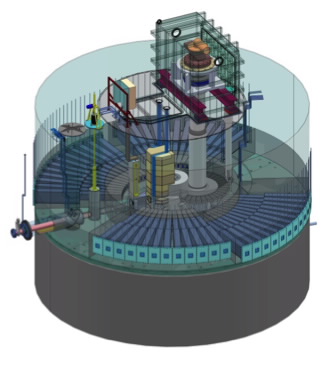 |
| Photo credit: European Spallation Source |
The new European Spallation Source (ESS) will have 22 instruments from a high power neutron source, when it begins user operations in 2026, providing an expansive selection of research opportunities, according to Aff. Prof. Markus Strobl, Deputy Head of the Instruments Division, ESS.
A number of ANSTO scientists have an association with the ESS, including membership in the Reflectometry Group of the Instrument, Scientific and Technical Advisory Panel; participation in an expert panel to review options and challenges in determining high neutron brightness; and providing expertise in planning the ODIN instrument.
ESS Instrument scientist Hanna Wacklin, a post-doc Fellow at ANSTO’s National Deuteration Facility from 2006-2009, is at ANSTO this month to use PLATYPUS for her research.
Aff. Prof. Strobl delivered a presentation as part of the Bragg Institute Seminar Program on 19 March, which provided the most up-to-date progress on the construction of the new collaborative science facility at Lund Sweden.
The members of the collaboration comprise 18 European countries led by Sweden and Denmark. The group will eventually assume ownership when it becomes the European Research Infrastructure Consortium.
“At a cost of €2 billion, it is the largest scientific infrastructure project in Europe,” said Strobl, who has been closely involved in instrumentation planning for the complex. Construction of the complex commenced in 2014.
The neutrons that are needed for the instruments are produced by spallation. An accelerator generates protons to reach energy of 2GeV in a long pulse that is directed into an 11-tonne helium cooled tungsten wheel (the target).
The heavy metal target absorbs the proton beam from the accelerator and transforms into fast neutrons. The liquid hydrogen moderator-reflector surrounding the target transforms the fast neutrons emitted by the target into slow neutrons, making them useful for research.
The beam-extraction system will consist of more than 40 beam tubes arranged in sectors.
The process of selecting instruments is done collaboratively based on a call for proposals that is followed by a review that engages expert reviewers from around the world. ESS will provide neutrons for ten classes of instruments in total.
Aff. Prof. Strobl shared details of the Beamline for European Engineering Research (BEER) the Optical and Diffraction Imaging with Neutrons (ODIN) instrument. These instruments were chosen from proposals received in 2012 and 2013 and are among the total of 12 instruments approved by the ESS Steering Committee. The first neutrons are scheduled to be produced in 2019 and up to 3000 scientists a year are expected to use the facility.
Aff. Prof. Strobl was at the Bragg Institute investigating cracks and deformations in commercial solid oxide fuel cell stacks on DINGO with the assistance of instrument scientists, Ulf Garbe and Floriana Salvemini.
Read about the progress in Nature.
Published: 20/03/2015


